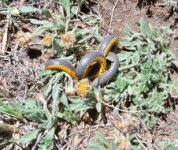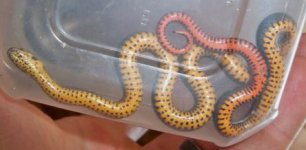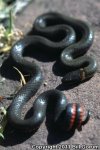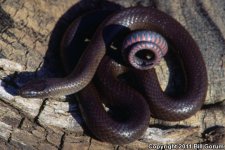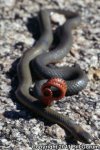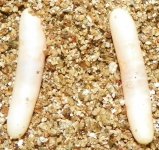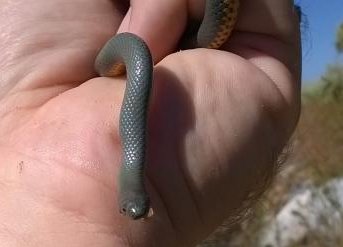| Range: |
 |
| Other Names: |
Arny's Ring-necked Snake, Red-bellied Snake, Punctated Viper Ring Snake, Western Ring-necked Snake |
| Subspecies: |
Prairie Ringneck Diadophis punctatis arnyi: dark head color extends around or across angles of the jaw, slightly forward on lower jaw; neck ring sometimes interrupted; yellow venter turns red posteriorly; belly spots numerous, highly irregular; usually 17 scale rows anteriorly.
Regal Ringneck Diadophis punctatis regalis: among largest Ringnecks, up to 33 5/8"; plain greenish, brownish or pale slate gray (pale bluish gray in juveniles); neck ring usually absent, sometimes partially indicated or complete; belly yellow, yellow extending onto first or first and second scale rows, irregularly spotted with black, turning to bright orange-red near and under tail; usually 17 scale rows anteriorly and midbody.
|
| Description: |
An up to 34 inches long gray snake with a ring (often absent in Diadophis punctatus regalis) of yellowish orange around its neck. The belly is usually the same color as the ring and gets redder toward the tail. The belly has a double or triple row of half-moon shaped black spots. |
| Similar Species: |
Black-headed snakes usually have whitish or beige neckband and lack black spots on belly; reddish color on belly is bordered on each side by pale gray and there is no loreal scale. |
| Venom: |
Rear-fanged, not considered dangerous to humans. Nicolette Emms was bitten by Diadophis punctatus arnyi and her finger turned red and swelled slightly. She had mild pain for less than a day. I have heard annectdotal evidence that the venom is very potent on reptiles. Keepers who have kept both Diadophis punctatus regalis and Micruroides euryxanthus euryxanthus have said that the prey tends to die quicker from a D. p. regalis envenomation. |
| Habitat: |
This species prefers to live on rocky, wooded hillsides, but it can be found in native prairies, pastures, grasslands, edges of woodlands, and on dry, rocky glades. Secretive, they often use flat rocks, boards, logs, or bark slabs for shelter. Instead of regulating their body temperature by basking in the sun on top of rocks, they rest beneath sun-warmed rocks. In the hottest part of summer, they seek cooler temperatures by taking shelter in the soil. |
| Behavior: |
Spend most of their time underground. When agitated, they frequently curl up their tail and expose the red underside. Captured individuals often drool from the corner of the mouth, possibly the result of the secretion of venom. |
| Hibernation: |
Overwintering retreats include burrows of other animals and deep crevices in rock outcrops. |
| Reproduction: |
Breeding occurs soon after emergence from overwintering, in late March or early April. Egg-laying takes place from late June through early July. Females lay 1-18 eggs. There is evidence that this species may nest communally. Eggs are laid in abandoned small mammal burrows or under large flat rocks. The young hatch in late August or early September. The hatchlings are about 4 inches long. |
| Diet: |
Earthworms, small invertabrates, small lizards and small snakes |




